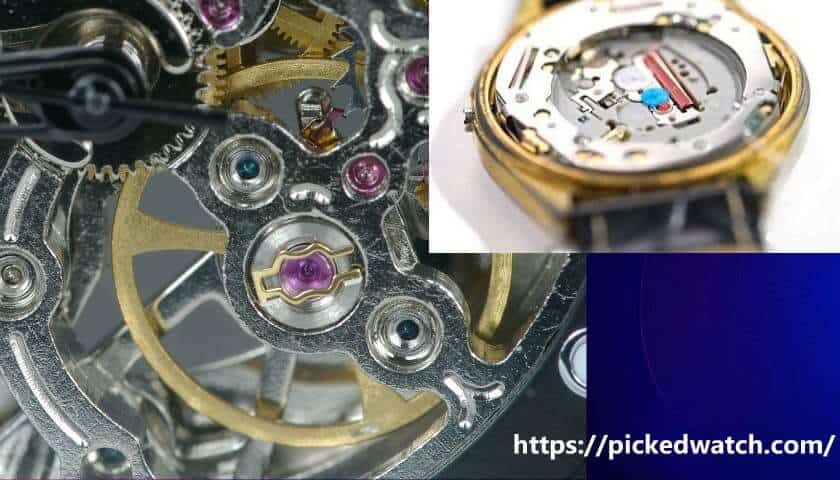Why are Jewels Used in Automatic Watches | The Secret Behind This!

As an Amazon Associate, I earn from qualifying purchases.
Curious about why are jewels used in automatic watches? Then allow us to answer most of your questions relating to the use of jewels in automatic watches!
In most of these timepieces, they are used to improve the overall functioning of the timepiece. People usually perceive that the purpose of trinkets is just decoration. Some people still believe that trinkets are used to add value to the timepiece. They may have a number of stones or gems. They are added to overcome the friction between the movable parts of the clock. Less friction means more accuracy.
In these timepieces, the movable parts can wear and tear easily without trinkets or gems. This is because of high-intensity friction. They reduce the friction; hence the wear and tear are also reduced. They also ensure the durability of timepieces because when the timepiece damage is less, the clock will last for a more extended period of time. With the addition of gems, automatic watches become heirloom watches that can be passed on.
Read next: Why Automatic Watches are Better
What do Jewels do in a Watch?

A timepiece seems very simple, but a lot of complexity and sophistication are enclosed in it. Adding gems to a clock certainly enhances its sophistication. It also increases the price value of the timepiece as well. However, gems or trinkets in timepieces are not merely decoration. They help in improving the functioning of the timepiece
1. Overcoming Friction
In most of the mechanical timepieces, bearings are used. Since there is no lubrication, the moving parts inside the clock or bearings can be worn out super quickly. This is because of high-friction between the moving parts of the timepiece. In earlier times, precious gems in timepieces were used to overcome friction. However, in the modern world, synthetic gems or trinkets are used as well.
2. Ensuring Accuracy
Gems in a timepiece contribute to attaining accuracy. The hindrance in the accuracy of a clock is due to “friction.” The greater the friction, the greater will be the disturbance in the functioning of the timepiece. By adding gems to the moving parts, the friction is reduced. With reduced friction, accuracy is achieved. The variations in time are certainly decreased.
3. Increasing life
The durability or life of the timepieces increases with the addition of stones. This is because the moving parts of the clocks do not get worn out quickly. Also, the stones can be replaced as well when needed. So, the watches with stones last for quite a while.
The stones in timepieces are much valued because they are very smooth. The smoothness of the stones allows the moving parts of the watch to move easily. The smoothness also decreases friction.
History of Jewels in Watches
Jewel bearings were invented in the year 1704. Since then, a variety of precious gems have been used in a timepiece. Gems such as rubies, sapphires, diamonds, and even garnets were used.
Sapphires were the most commonly used because of their hardness. They were even used to create scratch-resistant timepiece faces.
Emeralds were also used, and they are still used for decorating the timepiece. Rubies have also been commonly used in a timepiece. Gems are selected while depending upon the sophistication of automatic or mechanical watch.
Watch jewels, a minor detail?
Timepiece gems play a vital role in the efficient working of a mechanical or automatic timepiece. This is why they are certainly not a minor detail that can be ignored. Lack of stones in automatic or mechanical timepiece means a lack of accuracy, lack of durability, and worn out moving parts of the timepiece.
Are more jewels in a watch better | Myth or Not?
Due to the marketing of the timepiece brands, a wrong idea has been spread throughout the years. The idea is that the greater number of gems in a timepiece is better.
It is important to understand that there are functional stones and non-functional stones.
- The minimum number of jewels: The minimum number of stones in a mechanical or automatic timepiece is 7. These timepieces were mostly found before the 1970s. The modern timepieces now have 17 jewel movements.
- The maximum number of jewels: The number of stones in a timepiece increases depending upon the complexity. There are timepieces available that have 21 jewel movement, and some may have 25 jewel movement. It may even increase for more complex timepieces!
- 25 Jewel movement: The self-winding consist of 17 stones. They are known as fully jeweled timepieces. This is because they contain stones from the balance wheels to the pivots. They have added 8 gems. Out of which, 4 are at the lever and escape bearings. While the other 4 are at the barrel of the mainspring. So, the total number of jewel movement equals to 25.
How many jewels in a good watch?
This number of stones basically represents the number of pivots inside a timepiece. A higher number of jewel movements in a timepiece is a display of immense craftsmanship. But it doesn’t necessarily mean that the greater number of trinkets will make a watch much better.
A well-designed timepiece will have a limited number of stones. It will also be capable of ensuring high-performance and accuracy. Most gems in a watch that has 100 gems may be non-functional.
In automatic timepieces, the number of stones is higher because of the increase in complexity.
So, it is understood that the higher number of stones does not make a watch better. This is because some of the stones may not even be functional. They may be placed there for decoration and to increase the watch value.
Don’t think that the number of jewels is a sign of quality!
Are jewels in watches valuable?
The stones that are used in modern times are synthetic, and hence they are not valuable. They are a cheap alternative to natural and precious stones. In earlier times, precious stones such as diamond, ruby, and sapphire were used. They were certainly valuable. Not a lot of timepieces or brands have watches with precious gems.
There are some luxury timepieces that may still contain natural gems. They will certainly be valuable!
Synthetic Jewels in Watches
Natural stones can be costly. Not many people were able to get their hands-on automatic timepieces with natural stones. To reduce the price, synthetic stones are now used in timepieces. The synthetic stones are basically grown in the lab. A controlled environment is used for this purpose. These artificial stones are called “Boule.”
Boule
It is a French word that means “chunk of the cone-shaped material.”
Natural Jewels Vs Synthetic Jewels
As compared to natural stones, synthetic stones are easier to work with. The natural gems have a greater amount of impurities. These impurities are known as “inclusions” The milling and polishing of natural gems are difficult. Since the synthetic gems have a lesser grain, they can be easily polished. So, an effective and budget-friendly alternative of natural gems is synthetic jewels.
Fitting of Jewels
In the earlier times, the gems were rubbed into brass. The replacement of these gems was very difficult. So, to ensure ease of replacement, an easier method was adopted. Instead of the gems being rubbed in, the gems were pressed in. Rubbing in gems was a long process that required a lot of effort and time. On the other hand, the pressing of the gems was very easy.
Placement of Jewels
Jewels can be seen in various parts of the timepiece. The pivot bearings, winding components, calendar, and other parts of the timepiece contain gems. The pivots are made of steel that is highly polished. The pivots and the gems combine together to reduce the friction. Hence, the accuracy of the timepieces can be achieved.
Visibility of the jewels: The functional gems may or may not always be visible in some timepieces. Some timepieces that allow you to see the mechanism of the timepiece will show the gems. The timepieces that don’t show the timepiece mechanism will not show gems. However, when non-functional gems are used as decoration, they can certainly be seen.
Prices of Watches with Jewels
It is obvious that timepieces with natural stones are quite expensive. This is because the natural gems are precious and are quite expensive. So, the greater number of natural or precious gems in a timepiece will definitely increase the overall price. On the contrary, the timepieces with synthetic gems are less expensive. Although, they may be expensive when compared with quartz timepiece movement.
Raise of price due to jewels: Some timepiece makers add extra gems to timepieces, with the intention of increasing the prices. Also, there are a variety of brands that claim timepieces with gems to be luxury products. Hence, they have a higher price.
Wrap up!
The gems in automatic timepieces are not only decoration that makes the timepieces luxurious. They are placed in timepieces because of their specific purposes. They ensure the longevity and accuracy of the timepieces. Accurate time can be read through the timepieces that have gems. Gems are able to do it because of their smoothness. They enable the moving parts of the timepiece to move without hindrance. Timepieces with gems can be expensive, but the ones that have synthetic gems are less expensive.
As an Amazon Associate, I earn from qualifying purchases.
- Do Smartwatches Need Data Plans | All Things to know - July 14, 2022
- How to Charge Apple Watch Without Charger - July 10, 2022
- The 7 Best Smartwatches for Small Wrists | 2022 Ultimate Guide - March 5, 2022






